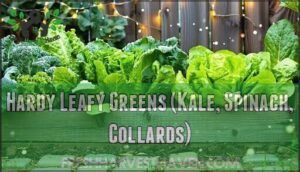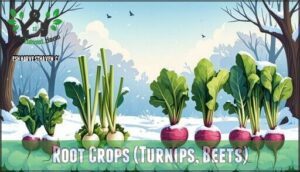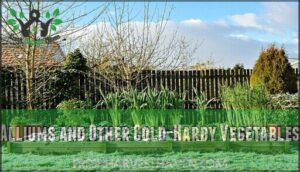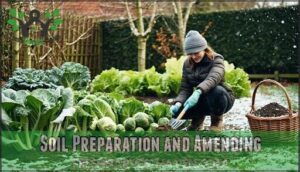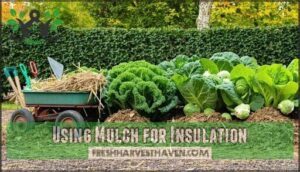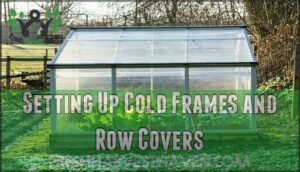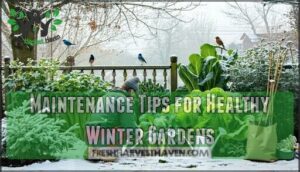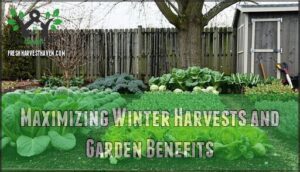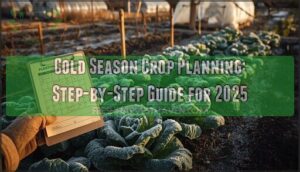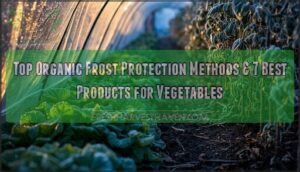This site is supported by our readers. We may earn a commission, at no cost to you, if you purchase through links.
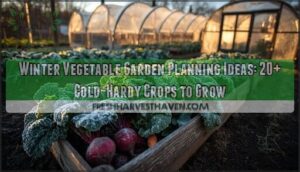
Create microclimates using row covers and cold frames to protect plants and extend growing seasons. Focus on sunlight optimization since winter days are shorter.
Root crops like turnips and beets actually taste sweeter after frost hits them. Succession plant every two weeks to keep harvests coming through the coldest months. The secret lies in understanding which vegetables thrive in cold weather and when timing becomes everything.
Table Of Contents
- Key Takeaways
- Planning Your Winter Vegetable Garden
- Best Vegetables to Grow in Winter
- Preparing and Protecting Your Winter Garden Beds
- Maintenance Tips for Healthy Winter Gardens
- Maximizing Winter Harvests and Garden Benefits
- Frequently Asked Questions (FAQs)
- How do you plan a Winter Garden?
- What can you plant in a winter vegetable garden?
- Can you grow vegetables in winter?
- Is gardening in winter a good idea?
- What is winter vegetable care?
- How to grow a garden in winter?
- What to plant in a winter vegetable garden?
- How to prepare vegetable garden beds for winter?
- Which vegetable is best to grow in winter?
- When should I start my winter garden?
- Conclusion
Key Takeaways
- Plant by your zone and beyond – Check your USDA zone and select cold-hardy crops one zone tougher than your area, then time plantings 8-12 weeks before the first frost for proper establishment.
- Create protective microclimates – Use cold frames, row covers, and strategic placement to shield plants from harsh weather while maximizing sunlight exposure during shorter winter days.
- Focus on frost-loving varieties – Choose hardy greens like kale and spinach, plus root vegetables like turnips and beets that actually taste sweeter after a frost hits them.
- Practice succession planting – Plant new crops every two weeks to ensure continuous harvests throughout winter, keeping fresh vegetables coming even in the coldest months.
Planning Your Winter Vegetable Garden
You’ll need to assess your USDA growing zone and select cold-hardy vegetables that can survive your local winter temperatures.
Plan your garden layout and planting schedule by late summer, since most winter crops require establishment before the first hard frost arrives.
Assessing Your Climate and USDA Zone
Why struggle with winter garden planning? Understanding hardiness zones determines your cold climate success. The USDA’s updated zones reflect average minimum winter temperatures across 13 zones, each split into A and B subzones. Your winter vegetable garden depends on proper zone assessment: The map uses extreme minimum winter temperatures to classify plant hardiness.
- Check your frost dates for precise planting windows
- Study microclimate mapping around your property
- Identify sunlight exposure patterns during winter months
- Research regional variations affecting local growing conditions
- Select crops one zone hardier than your designated area
Creating a Garden Layout for Winter
Now that you’ve identified your zone, it’s time to map out your winter vegetable garden layout. Focus on sunlight optimization by placing taller plants where they won’t shade shorter crops.
Space allocation matters—group plants with similar water needs together. Consider plant compatibility when arranging beds, keeping aggressive spreaders separate from delicate greens.
Design your garden spaces with microclimate zones in mind, using structures or terrain to create warmer pockets. **Smart plant placement maximizes your garden beds’ potential during cold months.
Timing Your Planting for Cold Months
Timing your planting for cold months requires calculating your first frost date and working backwards. Plant hardy greens like kale 10-12 weeks before frost, root vegetables 8-10 weeks prior. Consider your microclimate awareness – south-facing slopes stay warmer longer.
Succession planting every two weeks extends harvests through winter’s shorter seasonal day length periods.
Fall soil preparation, including adding compost and manure, creates a foundation for healthy growth.
Best Vegetables to Grow in Winter
You’ll find success with cold-hardy vegetables that can handle frost and freezing temperatures throughout winter months. Focus on leafy greens like kale and spinach, root crops such as turnips and beets, and sturdy alliums that continue growing even when snow covers your garden beds.
Hardy Leafy Greens (Kale, Spinach, Collards)
Hardy leafy greens form the backbone of any successful winter garden. Smart variety selection ensures continuous harvests throughout winter months.
Choose winter vegetables that taste better after frost hits – they’ll reward your patience with incredible sweetness
Kale offers outstanding cold tolerance and high nutrient content, thriving in temperatures down to 10°F. Spinach provides excellent pest resistance while delivering adaptable culinary uses. Collard greens withstand harsh freezing conditions better than most vegetables.
Root Crops (Turnips, Beets)
Root vegetables thrive in winter gardens, offering excellent nutrition and winter storage potential. Turnips and beets develop sweeter flavors after frost, making them perfect cold-weather companions.
- Turnip varieties like ‘Purple Top’ and ‘Hakurei’ excel in zones 2-9, withstanding mid-20°F temperatures
- Beet nutrition peaks in winter with concentrated sugars and vitamins from slow, steady growth
- Winter storage keeps these root vegetables fresh for months in root cellars or cold frames
Alliums and Other Cold-Hardy Vegetables
Garlic and onions are winter garden champions, offering outstanding cold-hardiness that lets them thrive in freezing conditions. Plant garlic cloves in fall for summer harvests, while scallions grow continuously through winter months.
These allium varieties provide natural pest resistance and bold flavor profiles. Try leeks, shallots, and chives for diverse companion planting options that boost your cold weather vegetables.
For ideal growth, remember to think about zone-based planting schedules.
Preparing and Protecting Your Winter Garden Beds
You’ll need to prepare your garden beds properly before winter sets in to guarantee your cold-hardy crops can survive harsh conditions.
Start by amending your soil with compost, adding insulating mulch, and installing protective structures like cold frames or row covers to shield plants from freezing temperatures and harsh winds.
Soil Preparation and Amending
Before planting cold-hardy vegetables, you’ll need well-draining soil with a proper pH balance between 6.0-7.0. Test for nutrient deficiencies and amend clay soils with compost to improve winter soil drainage.
Apply compost at two-inch depths and balanced fertilizer following package rates. Preparing soil for vegetables requires addressing compaction issues that freeze-thaw cycles worsen during garden planning season.
Using Mulch for Insulation
Think of mulch as your winter garden’s security blanket. Apply organic mulch types like straw or shredded leaves at a 2-4 inch depth around winter vegetables.
This layer provides moisture retention while offering temperature regulation for plant protection. Mulch also delivers pest control benefits by creating barriers against harmful insects in cold weather conditions.
Setting Up Cold Frames and Row Covers
Cold frames and row covers create microclimates that extend your winter vegetable gardening season. These protection systems shield crops from harsh weather while maintaining soil warmth. One major benefit is that they can extend the growing season by one to three months.
- Frame Materials: Use recycled windows, plexiglass, or polycarbonate panels for DIY construction
- Cover Ventilation: Open frames when temperatures exceed 85°F to prevent overheating
- Pest Control: Floating row covers block insects while allowing light transmission
- Snow Removal: Clear heavy snow loads to prevent structural damage
- Winter Garden: Position south-facing for maximum sunlight exposure
Maintenance Tips for Healthy Winter Gardens
Winter garden maintenance requires consistent attention to watering, fertilizing, and pest management to keep your cold-hardy crops thriving through harsh conditions.
You’ll need to adjust your care routine as temperatures drop, focusing on proper pruning techniques and disease prevention to guarantee healthy harvests all season long.
Watering and Fertilizing in Cold Weather
Winter watering needs change dramatically when frozen soil impact prevents proper absorption. Your winter vegetables require less water during dormancy, but consistent moisture remains essential.
Check soil moisture weekly since cold weather nutrients depend on adequate water for nutrient uptake. Avoid overwatering when feeding watering garden schedules.
Apply diluted fertilizer monthly during active growth periods for successful winter vegetable gardening results.
Pruning and Harvesting Techniques
Once watering and fertilizing routines are established, proper harvesting techniques become your next priority. Sharp pruning timing prevents stress on winter vegetables while maximizing yields. Use clean tools for disease prevention during harvests. To enhance flavor, consider morning harvesting benefits.
- Harvesting Frequency – Cut outer leaves weekly, leaving centers to regenerate
- Tool Selection – Use sharp, sanitized shears for clean cuts on stems
- Pruning Timing – Remove damaged foliage before frost sets in completely
- Storage Methods – Harvest in dry conditions for longer shelf life
- Winter Harvest – Pick during warmer midday hours when possible
Managing Pests and Diseases in Winter
Disease prevention and winter pest control require a proactive approach during cold months. Inspect your cold hardy vegetables weekly for signs of trouble. Remove diseased plant tissue immediately to prevent spread.
Use row covers for protecting winter crops from overwintering pests. Cold-weather IPM strategies work best when combined with beneficial insects and proper plant spacing for ideal winter garden care.
Maximizing Winter Harvests and Garden Benefits
You can turn your winter garden into a productive powerhouse by using smart techniques that extend harvests throughout the cold months.
Strategic planning and the right tools help you increase both yields and the many benefits of year-round growing.
Succession Planting and Indoor Seed Starting
Mastering succession planting and seed starting creates your continuous harvest system. Start seeds indoors every 14-21 days for steady winter vegetable gardening production.
Your indoor lighting setup and timing strategies determine seedling success. Choose variety selection that matches your growing conditions and harvest goals.
Proper seedling care ensures strong transplants when you grow winter vegetables year-round.
Four-Season Gardening Advantages
Year-round harvests transform your winter garden into a continuous production system. Space reallocation lets you optimize growing areas during off-peak seasons. Workload distribution spreads gardening tasks across twelve months, preventing summer burnout.
Winter vegetable gardening delivers fresher produce with enhanced flavors from cool weather.
Growing vegetables year-round promotes improved well-being by combating seasonal depression and maintaining outdoor activity.
Tools and Supplies for Winter Gardening
Success in your winter garden depends on having the right Winter Garden Gear ready before cold weather arrives. Essential tools and supplies make growing vegetables through harsh months manageable and productive.
- Soil Testing Kits – Monitor pH levels and nutrient content to guarantee favorable growing conditions for cold-hardy crops
- Pruning Shears – Keep plants healthy with clean cuts that prevent disease in your winter garden beds
- Garden Thermometers – Track soil and air temperatures to protect cold frames and row covers effectively
Watering Systems designed for cold weather prevent frozen pipes while maintaining proper moisture levels.
Frequently Asked Questions (FAQs)
How do you plan a Winter Garden?
While winter seems hostile to growing, you’ll plan your garden by selecting cold-hardy crops like kale and spinach, choosing proper protection methods, and timing plantings for late summer preparation.
What can you plant in a winter vegetable garden?
You can plant cold-hardy vegetables like kale, spinach, collard greens, Swiss chard, arugula, turnips, and beets. These crops withstand frost and continue growing in cooler temperatures throughout the season.
Can you grow vegetables in winter?
Like Jack Frost painting windows, you can absolutely grow vegetables in winter. Cold-hardy crops like kale, spinach, and turnips thrive in freezing temperatures, especially with protection from cold frames or row covers.
Is gardening in winter a good idea?
Gardening in winter is absolutely worth your time. You’ll enjoy fresh, flavorful vegetables when store prices peak. Cold-hardy crops like kale and spinach actually taste sweeter after frost hits them.
What is winter vegetable care?
You’ll protect, maintain, and harvest your cold-season crops through proper mulching, regular watering, frost protection, and timely harvesting to guarantee continuous production throughout winter months.
How to grow a garden in winter?
Start your winter garden by choosing cold-hardy vegetables like kale, spinach, and turnips.
Use cold frames or row covers for protection. Plant in late summer, prepare well-draining soil, and mulch heavily.
What to plant in a winter vegetable garden?
You’ll want cold-hardy vegetables like kale, spinach, and collard greens. Add turnips, beets, and Swiss chard for variety. These crops handle frost well and keep producing through winter.
How to prepare vegetable garden beds for winter?
Clear debris, add compost, and mulch beds deeply. Install row covers or cold frames for protection. Guarantee proper drainage to prevent waterlogged soil and root rot during winter months.
Which vegetable is best to grow in winter?
Like a steadfast soldier in winter’s harsh army, kale stands as your best cold-weather champion. You’ll find it thrives in frost, actually sweetening after cold snaps, and keeps producing nutritious leaves throughout winter’s toughest months.
When should I start my winter garden?
You’ll want to start planting your winter garden in late summer, usually 6-12 weeks before your first expected frost date. This timing gives plants enough time to establish.
Conclusion
Building a winter garden is like crafting a resilient fortress against harsh weather – strategic planning creates an impenetrable defense that yields abundant harvests. Your winter vegetable garden planning ideas will transform cold months into productive seasons.
You’ll discover that frost-kissed vegetables taste sweeter, cold frames extend growing periods, and succession planting ensures continuous harvests.
With proper timing, hardy crop selection, and protection methods, you’ll enjoy fresh vegetables year-round while building valuable four-season gardening skills.

